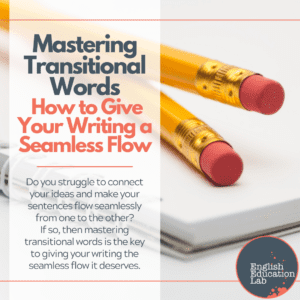
Mastering transitional words: How to give your writing a seamless flow
Are you tired of your writing feeling disjointed and lacking flow? Do you struggle to connect your ideas and make your sentences flow seamlessly from one to the other? If so, then mastering transitional words is the key to giving your writing the seamless flow it deserves.

Linking words are like the glue that holds your sentences and paragraphs together. They create a logical connection between ideas, helping readers navigate smoothly through your writing. From adding emphasis to contrasting ideas, transitional words enhance the clarity and coherence of your work.
In this blog post, we will explore the art of using transitional words effectively. We will delve into different types of transitions and provide practical tips on how to use them to improve the overall flow of your writing. Enhancing your writing to a professional standard involves mastering the art of using connective words, whether you are composing an essay, a blog post, or any other type of content. So, let’s say goodbye to choppy sentences and hello to a seamless flow in your writing!
Importance of a seamless flow in writing
When it comes to writing, a seamless flow is essential for keeping readers engaged and ensuring the clarity of your message. Without proper transitions, your writing can feel disjointed and confusing, making it difficult for readers to follow along. A seamless flow, on the other hand, allows your ideas to flow smoothly from one to the next, creating a logical and coherent piece of writing.
One of the main benefits of a seamless flow is improved readability. When your writing flows seamlessly, readers can easily understand the connections between your ideas, allowing them to follow the progression of your argument or narrative effortlessly. This not only makes for a more enjoyable reading experience but also ensures that your message is effectively communicated.
Furthermore, a seamless flow helps to maintain the reader’s attention. When readers encounter choppy sentences or abrupt transitions, it can be jarring and disrupt their reading flow. This can lead to frustration and disengagement, causing readers to lose interest in your writing. On the other hand, when your writing has a seamless flow, readers can stay focused and immersed in your content, eagerly anticipating what comes next.
In addition, a seamless flow enhances the overall professionalism of your writing. Whether you’re writing a blog post, an academic paper, or a business report, using transitional words effectively demonstrates your command over the language and your ability to present your ideas in a clear and organized manner. It shows that you have taken the time to carefully structure your writing, allowing your ideas to flow seamlessly from one to the next.
So, if you want to elevate your writing and captivate your readers, mastering the art of connective words is a must. Let’s explore the different types of transitions and how to use them effectively.
Common types of transitional words and phrases
Transitional words and phrases can be classified into different categories based on their purpose and usage. Understanding these categories will help you choose the most appropriate connective words for your writing.
1. Addition: These transitional words add information or ideas. They include words like “in addition,” “furthermore,” “moreover,” and “also.” For example: “In addition to his academic achievements, John is also an accomplished musician.”
2. Emphasis: These connective words highlight a particular point or add emphasis. They include words like “indeed,” “certainly,” “truly,” and “in fact.” For example: “Indeed, the results of the study confirm our initial hypothesis.”
3. Contrast: These transitional words show a difference or contrast between ideas. They include words like “however,” “on the other hand,” “in contrast,” and “nevertheless.” For example: “The weather was cold; nevertheless, we decided to go for a walk.”
4. Cause and Effect: These linking words indicate a cause or reason, as well as the resulting effect or consequence. They include words like “because,” “therefore,” “consequently,” and “as a result.” For example: “Because of the heavy rain, the match was postponed.”
5. Time: These connective words indicate a sequence of events or the passage of time. They include words like “first,” “next,” “then,” and “finally.” For example: “First, we need to gather all the necessary materials. Next, we can start the project.”
By familiarizing yourself with these common types of transitional words and phrases, you can choose the most appropriate ones to enhance the flow and coherence of your writing. But how do you effectively use these connective words within a paragraph? Let’s find out.
Using transitional words to connect ideas within a paragraph
Within a paragraph, transitional words and phrases help to establish connections between sentences and ideas, creating a smooth flow of information. Here are some tips to effectively use transitional words within a paragraph:

1. Choose the appropriate transitional word: Consider the relationship between the sentences you want to connect. Are you adding information, contrasting ideas, or showing cause and effect? Choose a transitional word or phrase that accurately reflects this relationship.
2. Place the linking word appropriately: Transitional words and phrases can be placed at the beginning, middle, or end of a sentence. However, it’s important to ensure that the placement makes sense and maintains the coherence of your writing.
3. Use a variety of connective words: Using the same transitional word repeatedly can make your writing monotonous. Try to use a variety of transitional words to add variety and depth to your writing.
4. Avoid overusing transitional words: While transitional words are important, it’s equally important not to overuse them. Overusing transitional words can make your writing sound forced and unnatural. Use transitional words where they are necessary and ensure that they enhance the overall flow and clarity of your writing.
5. Consider the context: Transitional words should fit naturally within the context of your writing. Consider the tone, style, and overall message of your piece when selecting transitional words.
6. Read your writing aloud: Reading your writing aloud can help you identify any awkward or forced transitions. If a linking word sounds out of place or disrupts the flow, consider revising or replacing it.
By following these tips, you can effectively use linking words to connect ideas within a paragraph, creating a seamless flow of information. But what about transitioning between paragraphs? Let’s explore.
Using transitional words to transition between paragraphs
Transitional words not only help to connect ideas within a paragraph but also facilitate smooth transitions between paragraphs. These transitions guide readers from one paragraph to the next, ensuring a seamless flow of information. Here are some tips for using linking words to transition between paragraphs:
1. Establish a clear connection: When transitioning between paragraphs, it’s important to establish a clear connection between the ideas in the previous paragraph and the ideas in the next. Use connective words that reflect this connection.
2. Use transitional phrases: Instead of using single connective words, consider using transitional phrases to transition between paragraphs. These phrases provide a more comprehensive connection between ideas.
3. Preview the next paragraph: Use transitional words or phrases to provide a preview of what the next paragraph will discuss. This helps to prepare readers for the upcoming information and ensures a smooth transition.
4. Revisit previous ideas: Linking words can also be used to refer back to ideas discussed in previous paragraphs. This reinforces the connections between ideas and helps readers follow the progression of your writing.
By incorporating these tips into your writing, you can effectively use linking words to transition between paragraphs and maintain a seamless flow of information. But where can you find the right transitional words for your specific needs? Let’s explore some tools and resources.
Tools and resources for finding and using transitional words
Finding the right transitional words for your writing can be challenging, especially if you’re unfamiliar with the different types and usages. Fortunately, there are several tools and resources available to help you find and use transitional words effectively. Here are a few:
1. Thesaurus: A thesaurus is a great tool for finding synonyms and related words. Use a thesaurus to explore different transitional words and find the ones that best fit your needs.
2. Style guides: Style guides, such as The Chicago Manual of Style or the AP Stylebook, provide guidance on language usage and can help you identify appropriate transitional words for different purposes and contexts.

3. Online writing communities: Joining online writing communities, such as forums or writing groups, can provide opportunities for discussion and sharing of resources. Other writers may have recommendations for useful tools or resources for finding and using transitional words.
4. Grammar and writing websites: Websites dedicated to grammar and writing, such as Grammarly or Purdue Online Writing Lab, often provide comprehensive guides and resources on transitional words.
These resources can offer insights and examples to help you improve your use of transitional words. By utilizing these tools and resources, you can enhance your understanding and usage of transitional words, ultimately improving the flow and coherence of your writing. However, like any skill, effective use of transitional words requires practice. Let’s explore some practice exercises to help you improve your use of transitional words.
Practice exercises to improve your use of transitional words
Improving your use of transitional words requires practice and application. Here are some practice exercises to help you enhance your skills:
1. Sentence completion: Take a sentence and experiment with different connective words to complete it. Consider the purpose and relationship you want to convey and choose the most appropriate transitional word.
2. Paragraph revision: Take a paragraph from your writing and revise it by incorporating linking words. Focus on creating smooth transitions between sentences and ideas, ensuring a seamless flow of information.
3. Reading analysis: Read articles, essays, or books by skilled writers and analyze how they use connective words. Pay attention to the purpose and placement of transitional words and how they contribute to the overall flow and coherence of the writing.
4. Peer review: Exchange your writing with a peer and ask them to review your use of transitional words. They can provide feedback and suggest improvements to enhance the flow and clarity of your writing.
By actively practicing and applying connective words in your writing, you can improve your skills and confidently use them to create a seamless flow.
Final thoughts
Mastering the use of linking words is a skill that can greatly enhance the flow and coherence of your writing. By understanding the different types of transitions and applying them strategically, you can create a seamless reading experience for your audience.
Remember to use linking words sparingly, understand the context, vary your transitions, and take the time to edit and revise. With practice and attention to detail, you will become a master of liking words and elevate your writing to new heights.
So, what are you waiting for? Start incorporating connective words into your writing today and experience the transformative power of a seamless flow. Happy writing!
Get your ‘Free Cheat Sheet on Understanding the English Articles’ here!
Get your ‘Free Guide to Speaking English with Confidence- Your 5-Step Roadmap’ here!
Subscribe to my YouTube Channel!
Further Reading
Demystifying the present perfect tense: From confusion to clarity
Social media slang: Boost your online communication skills with these must-know terms
How to train your brain to think in English
Level up your English job interview skills: Expert strategies for success
Why accent reduction matters in today’s globalized world
The top 10 ESL podcasts you need to listen to right now!
Small talk- Why it matters and how to master it



